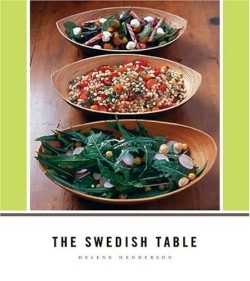The Swedish Table
The extent of most Americans’ knowledge of Swedish food probably consists of Swedish meatballs and a vague conception of a smörgàsbord. Swedish meatballs with gravy are here, of course, along with an explanation of smörgàsbord, which bears little resemblance to the all-you-can-eat indulgences that bear its name at American restaurants. For the uninitiated who appreciate good food, this book will be a welcome experience, as fresh as the berries for its chilled blueberry soup recipe, with citrus-infused crème fraîche.
The author runs a catering business in Los Angeles, where she creates updated and Hollywood versions of the Swedish meals she grew up eating. Henderson’s biography, as related in the introduction and in bits and pieces throughout the book, makes for interesting reading itself.
She was born and raised in a small steel town in northern Sweden. Her Swedish mother and African-American father, a jazz musician, married and divorced “in quick progression,” leaving Henderson to grow up as “the sole African-American amid a sea of blue-eyed blonds.” She never saw another person of color until she came to the U.S. as a teenager to visit her father. She learned to cook by working at restaurants, including a French bistro where she covered for the talented chef imported from Stockholm, who “became a complete drunk halfway through his first winter,” unable to cope with the dark days and small town life.
French influence is clear here, with lots of cream sauces and a preference for fresh ingredients. Henderson updates the recipes for the American kitchen and tastes, and draws inspiration from the regional cooking of her adopted country, such as her addition of chipotle adobe crème sauce to the traditional artic-shrimp-and-cucumber sandwich. The head notes usually mention when such adaptations have occurred, and briefly explain the traditional preparation.
The recipes are grouped into ten categories, and the most authentic recipes are in the section for desserts, pastries, and bread, the dishes that would be served as part of fika. “The most important custom in Sweden,” Henderson explains, “is the art of fika. The day begins and ends with fika, and it happens many times between while you talk about the weather.” In its simplest incarnation, fika consists of coffee and a small cookie or pastry eaten with friends, though it can also grow to more elaborate presentations depending upon the importance of the company. Simple or elaborate, bulla (a cinnamon-sugared roll with hints of cardamom) is a staple. But fika is more than a snack. More important is the custom, the interaction with loved ones. Henderson’s mother is dismayed at the absence of fika in American culture.
Americans could benefit from learning about the Swedish table, both the food on it and the customs and culture surrounding it. The Swedish Table makes a fine introduction to both.
Disclosure: This article is not an endorsement, but a review. The publisher of this book provided free copies of the book to have their book reviewed by a professional reviewer. No fee was paid by the publisher for this review. Foreword Reviews only recommends books that we love. Foreword Magazine, Inc. is disclosing this in accordance with the Federal Trade Commission’s 16 CFR, Part 255.

